Suivez nous sur les réseaux sociaux
Cet outil a vocation à informer, diffuser l’information auprès des jeunes cardiologues (internes, assistants, chefs de cliniques, jeunes praticiens, etc.), et faciliter les échanges.
Voici un aperçu rapide des sujets abordés dans cette publication :
Toutes nos publications
Une question ?
Publications
Prognostic value of right ventricular dilatation in patients with COVID-19: A multicentre study
Voici un aperçu rapide des sujets abordés dans cette publication :
Prognostic value of right ventricular dilatation in patients with COVID-19: A multicentre study
Laurie Soulat-Dufour, Charles Fauvel, Orianne Weizman, Thomas Barbe, Théo Pezel, Delphine Mika, Joffrey Cellier, Laura Geneste, Vassili Panagides, Wassima Marsou, Antoine Deney, Sabir Attou, Thomas Delmotte, Sophie Ribeyrolles, Pascale Chemaly, Clement Karsenty, Gauthier Giordano, Alexandre Gautier, Baptiste Duceau, Willy Sutter, Corentin Chaumont, Pierre Guilleminot, Audrey Sagnard, Julie Pastier, Antonin Trimaille, Guillaume Bonnet, Marjorie Canu, Augustin Coisne, Ariel Cohen
European Heart Journal – Cardiovascular Imaging, Volume 23, Issue 4, April 2022, Pages 569-577
PMID: 34008835
DOI: 10.1093/ehjci/jeab067
Abstract
Aims
Although cardiac involvement has prognostic significance in coronavirus disease 2019 (COVID-19) and is associated with severe forms, few studies have explored the prognostic role of transthoracic echocardiography (TTE). We investigated the link between TTE parameters and prognosis in COVID-19.
Methods and Results
Consecutive patients with COVID-19 admitted to 24 French hospitals were retrospectively included. Comprehensive data, including clinical and biological parameters, were recorded at admission. Focused TTE was performed during hospitalization, according to clinical indication. Patients were followed for a primary composite outcome of death or transfer to intensive care unit (ICU) during hospitalization. Among 2878 patients, 445 (15%) underwent TTE. Most of these had cardiovascular risk factors, a history of cardiovascular disease, and were on cardiovascular treatments. Dilatation and dysfunction were observed in, respectively, 12% (48/412) and 23% (102/442) of patients for the left ventricle, and in 12% (47/407) and 16% (65/402) for the right ventricle (RV). Primary composite outcome occurred in 44% (n = 196) of patients [9% (n = 42) for death without ICU transfer and 35% (n = 154) for admission to ICU]. RV dilatation was the only TTE parameter associated with the primary outcome. After adjustment, male sex [hazard ratio (HR) 1.56, 95% confidence interval (CI) 1.09 – 2.25; P = 0.02], higher body mass index (HR 1.10, 95% CI 1.02 – 1.18; P = 0.01), anticoagulation (HR 0.53, 95% CI 0.33 – 0.86; P = 0.01), and RV dilatation (HR 1.66, 95% CI 1.05 – 2.64; P = 0.03) remained independently associated with the primary outcome.
Conclusion
Echocardiographic evaluation of RV dilatation could be useful for assessing risk of severe COVID-19 developing in hospitalized patients.


